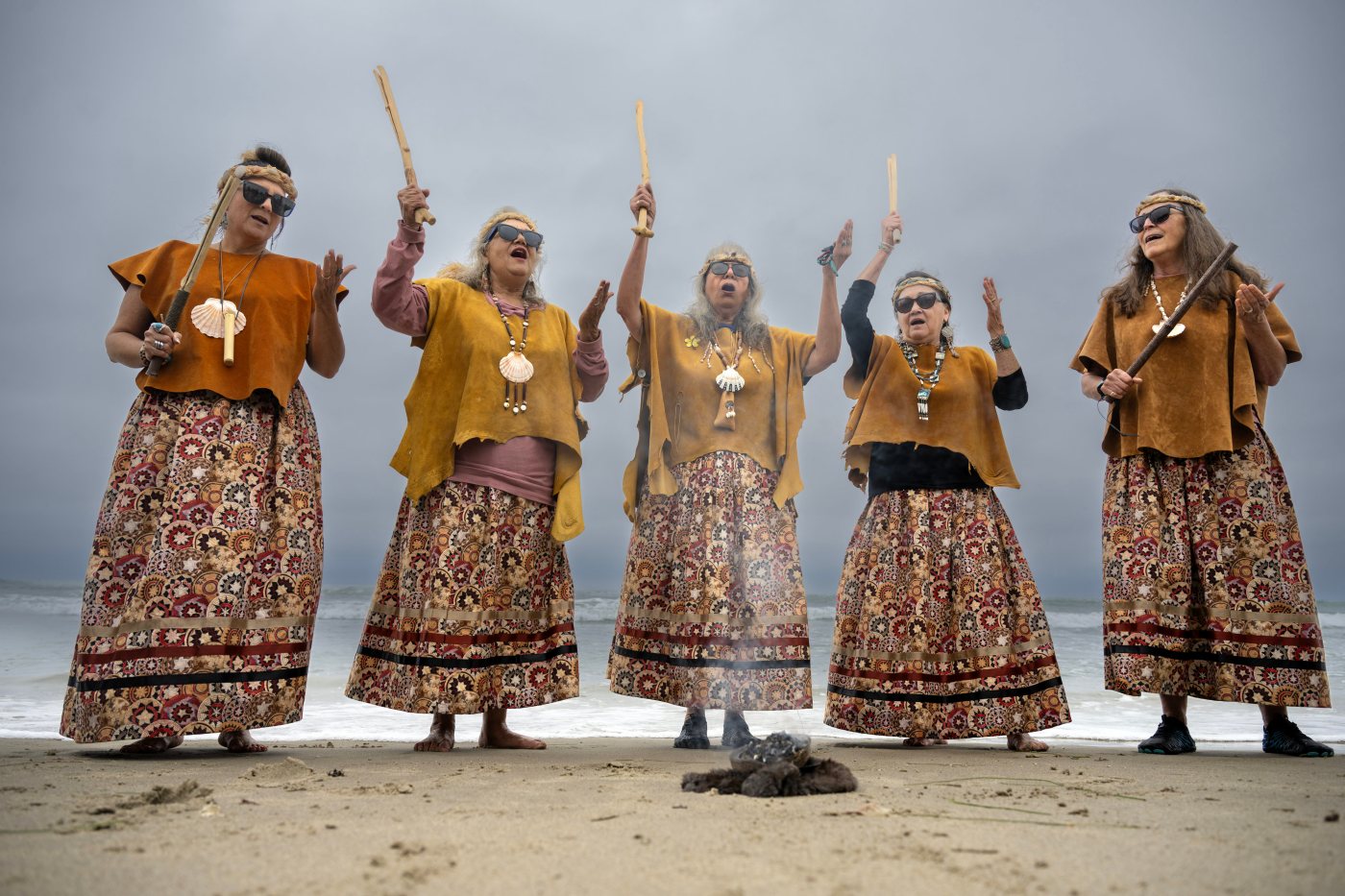The smell of sage filled the salt-water air, the white smoke wafting in the wind. Surfers were blessed for safety, as tribal chants echoed over the sand and sea at Lower Trestles.
The Lexus Trestles Pro opening ceremony on Sunday, June 8, wasn’t just a chance to kick off the surf contest happening in coming days at the beach south of San Clemente, but was also an educational opportunity to put a spotlight on the region’s Juaneño Band of Mission Indians, Acjachemen Nation, who for thousands of years called this coast home.
“It’s very important we keep our traditions alive and honor them and teach them to our children,” said tribal chairman Nathan Banda. “Because if we don’t, it’s going to get lost.”
Just as spiritual overseer Adelia Sandoval placed burning white sage on a bed of abalone shell and the fur of a rabbit on the sand Sunday, a wave suddenly washed up on shore to give it a salt-water kiss.
“That was a blessing,” Sandoval said with a smile.
Sandoval and a group of singers chanted as they held the sage up to bless three San Clemente surfers – brothers Griffin and Crosby Colapinto and friend Cole Houshmand – who will be competing in the upcoming Trestles Pro.
Sometimes, the ocean is fierce, sometimes calm, she said. And surfers know the ocean, connecting with the waves daily.
“You have wisdom you need to share, as well as we have wisdom to share from our ancestral past,” she said. “Our ancestors knew the beauty of the ocean.”
The dolphins were relatives, she said, and creatures and plants from the sea were used as medicine.
“That’s what we’re doing today, we need to get back to that strong relationship,” she said. “We need to return to that, because that’s what’s going to save us all.”
Crosby Colapinto, among the world’s top surfers, said he’s learned much during ceremonies WSL holds with indigenous cultures at the various contest stops, from Hawaii to Australia and beyond.
“It’s cool to acknowledge it and see it, and see what their rituals are and see what their tribe is like,” he said.
It’s especially poignant at the place where he grew up riding waves.
“You forget where California came from, they were here way before everyone in San Clemente,” he said. “It makes you think about how long these people have been here.”
Andrea Poveda, World Surf League manager for environmental and social impact, said the collaboration emerged from a shared commitment to honor the Indigenous stewards of the coastal lands and waters where surf events are held.
“The Acjachemen people have cared for and maintained a spiritual and cultural relationship with this region for over 10,000 years,” she said in an email. “From the beginning, our engagement with the Acjachemen Nation has been centered on respect and cultural recognition, and over time it’s evolved into an even more integrated and collaborative partnership.”
At San Onofre State Park, wedged between Orange County and San Diego County, that meant weekly conversations to learn about the Acjachemen Nation, tribal members teaching about what coastal living was once like in the watershed.
The tribal territory has a reach from Oceanside to Long Beach and inland to Lake Elsinore, Banda said, with more than 265 recorded villages in Orange County alone. The tribe that lived near San Mateo Creek had a deep relationship with the ocean.
Trophies for the contest winners were designed to pay homage to the Acjachemen Nation, created by artist Andeaux Borunda.
The trophies’ base is wood from the Santa Fe Railroad ties and spikes from the original trestle bridge built in the area in 1941, the namesake for the surf spot dubbed Trestles in the ’50s.

Many tribal members helped to build the railroad that created a connection between Los Angeles and San Diego.
The Juaneño Band of Mission Indians were not sent to a reservation, but assimilated into society, joining the workforce, said Banta.
Borunda dug up the rail ties, removed in 2010 after the track was rebuilt and found at a railroad dump in Riverside, to add to the trophies.
Borunda also used California Palm, sisal fiber and clay ceramic plates, as well as abalone shell in the design. Abalone is a precious commodity for not just food, but its shell is important for making jewelry and was used for trading with desert tribes.
On the bottom of the trophy is the Acjachemen “Star Man,” a logo often used by the tribal people.
For Banta, Trestles is a special place not just because it is home to his ancestors, but also because “it’s still the same, untouched, for the most part,” he said.
Borunda has been surfing the area since the ’80s, never knowing the rich history of the people who once called it home. Through his research in creating the awards, he said he learned so much.
“We owe the Native Americans so much. They are not as recognized as they should be,” he said. “I think a lot of times we overlook the roots of who was here before us.”
The Acjachemen Nation has also collaborated with World Surf League’s One Ocean, California State Parks, San Onofre Parks Foundation and other local organizations, to restore native habitats and elevate the visibility of their environmental stewardship, Poveda said.
The relationship also creates opportunities for surfers and fans to learn directly from tribal leaders about the sacred lands, she said.
“It’s essential that we recognize and honor the original stewards of these lands, especially when our events take place in areas that hold deep cultural, spiritual, and ecological significance,” Poveda said. “For the Acjachemen Nation, San Onofre is more than a surf break. It’s a sacred site, a burial site, and a place where freshwater and saltwater meet, which holds profound meaning in their culture.”











